India, Europe and Africa 2016
Jaisalmer is perched on the edge of the thar desert in the far west of Rajasthan. Initially it was established as a trade town along a camel route between India, Africa and the West. The area was very prosperous at this time but when Mumbai and other seaside cities were established as major ports, the need for transporting goods overland in this area diminished and Jaisalmer lost its purpose. Not idyllically, it's saving grace has been the mere 100kms to the Pakistan border, making it a strategically important place for an army base. For the first time we arrived at a train station and weren't mobbed by rickshaw drivers, but we did have to dodge men with machine guns. I'm not sure which is more intimidating.
The further West we ventured, the more we struggled with the heat of the day and we were expecting Jaisalmer to be unbearable. Fortuitously the first day we were there was relatively overcast, and a strong breeze developed which didn't waiver until our final day. The holi festival, otherwise called the festival of colours, is the second biggest hindu festival of the year. Traditionally holi represents a celebration of good triumphing over evil, the end of winter and coming of spring, and a time to mend broken relationships. We meandered our way into town and joined in with the celebrations for the morning in the streets within Jaisalmer fort, where currently about 4000 people still live. By lunchtime we were caked in colour and the men were getting pretty rowdy, so we found a good spot on some large steps overlooking the main square to observe the boisterous dancing and chanting to drums, and throwing of colour onto everything that moves. Everyone had a blast except the
emily.j.buswell
30 chapters
16 Apr 2020
Jodhpur to Jaisalmer
Jaisalmer
Jaisalmer is perched on the edge of the thar desert in the far west of Rajasthan. Initially it was established as a trade town along a camel route between India, Africa and the West. The area was very prosperous at this time but when Mumbai and other seaside cities were established as major ports, the need for transporting goods overland in this area diminished and Jaisalmer lost its purpose. Not idyllically, it's saving grace has been the mere 100kms to the Pakistan border, making it a strategically important place for an army base. For the first time we arrived at a train station and weren't mobbed by rickshaw drivers, but we did have to dodge men with machine guns. I'm not sure which is more intimidating.
The further West we ventured, the more we struggled with the heat of the day and we were expecting Jaisalmer to be unbearable. Fortuitously the first day we were there was relatively overcast, and a strong breeze developed which didn't waiver until our final day. The holi festival, otherwise called the festival of colours, is the second biggest hindu festival of the year. Traditionally holi represents a celebration of good triumphing over evil, the end of winter and coming of spring, and a time to mend broken relationships. We meandered our way into town and joined in with the celebrations for the morning in the streets within Jaisalmer fort, where currently about 4000 people still live. By lunchtime we were caked in colour and the men were getting pretty rowdy, so we found a good spot on some large steps overlooking the main square to observe the boisterous dancing and chanting to drums, and throwing of colour onto everything that moves. Everyone had a blast except the
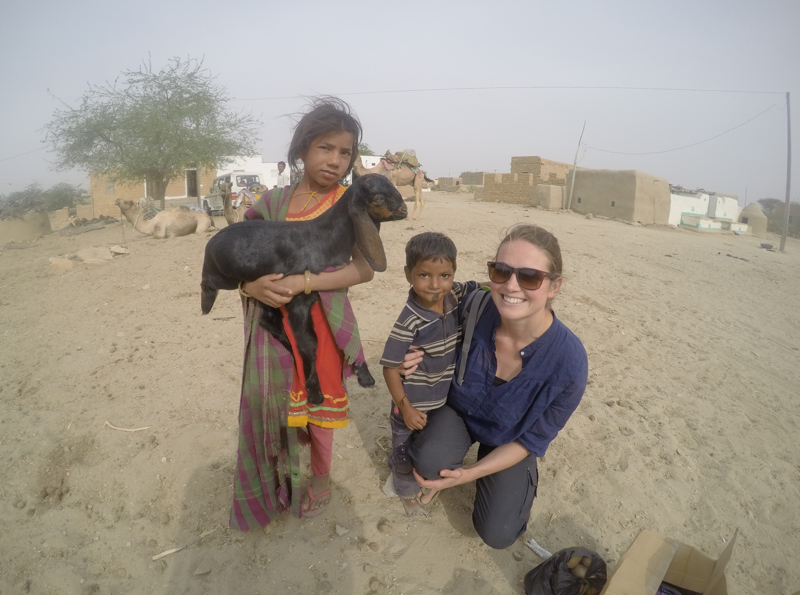
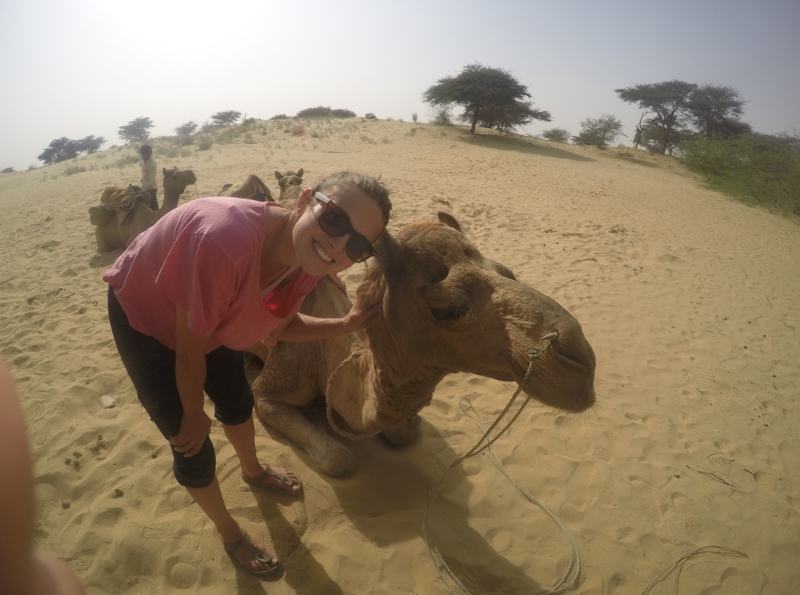
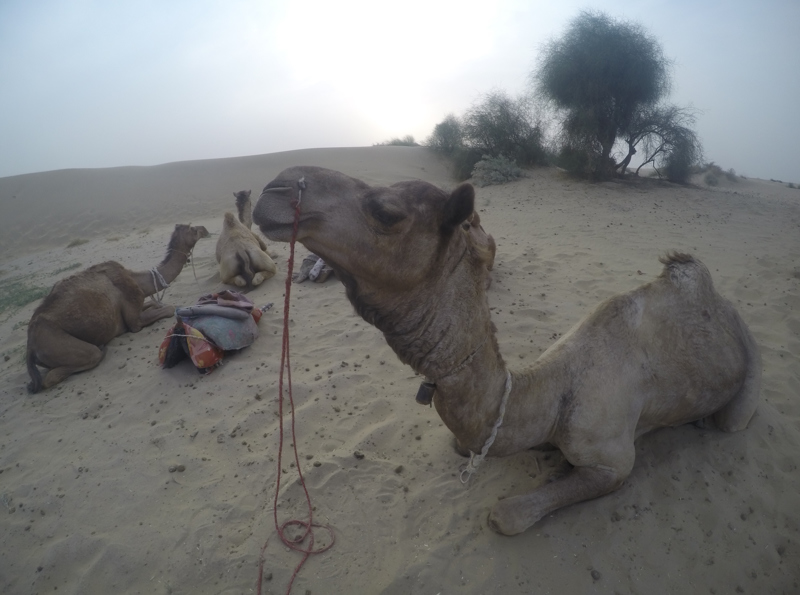
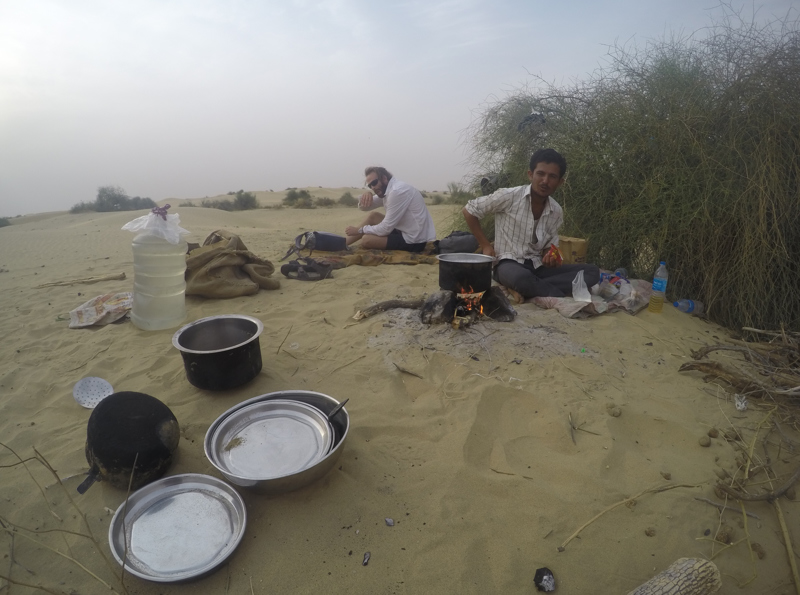

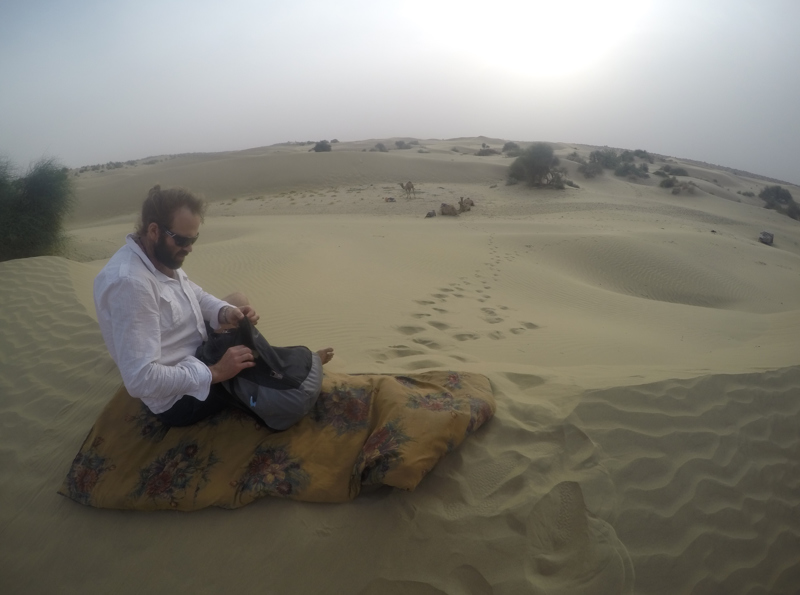
occasional person wearing their best clothes not intending on being involved, which wasn't really an option. It all died down at about 2pm which I thought was pretty civil, and we headed back to our guesthouse, not without being accosted by the masses along the way. It took almost a week and multiple washes using sard wonder soap to get rid of the colour. No doubt there will be dogs and cows running around carrying the festive spirit of the day with them for weeks to come.
The following morning we headed out into the desert early to start an overnight camel trek. After being warmly welcomed by some local kids, we headed off. Our camel driver seemed pretty subdued and non-communicative to start with, and our first stop was a small village.. Here the camels had a drink and he dropped us at a village home when we had some goats milk chai. Although in general the family were welcoming, for the first time of the trip we didn't feel very comfortable. No one could communicate with us though they tried repeatedly in Hindi, and one of the women repeatedly snuffed black powder. I only realised how uneasy I was feeling when a goat wandered into the room and walked over to greet us. An overwhelming sense of familiarity and understanding passed over me. Querying my sanity, I looked across at Liam who reassuringly was in the middle of asking it what mischief it had been up to and how much milk it had made today. Though nothing untoward happened and I'm sure the unease I was feeling was only because of a lack of understanding of our cultural differences, we were left wondering what the next 24 hours with the camel driver was going to be like.
We had a leisurely, long lunch in the shade, and while the driver whipped up some delicious chapatis and curry, he confessed to us that the night before had been a big one because of holi and he wasn't in top shape. A sleep in the shade must have been what the doctor ordered because in the afternoon he was much more jolly. Whilst we were stopped for lunch, a mob of about 200 sheep and goats moved through our camp followed by their herdsmen. I'm the first to admit that I've got a soft spot for sheep, but even I was surprised at how neat it was to watch them all meandering amongst the desert trees, nibbling here and there in their small groups. Long- eared and black and white, they look like a cross between a sheep and a boer goat. Their breed is very naturally called Jaisalmeri, and they are kept for wool and meat. I can't say having a coat of wool in the desert appeals to me, but it didn't seem to be slowing them down too much. Perhaps it keeps them cool.
The most disappointing thing about the camel riding was that we had to stay In a camel train with each of our camels tied to the camel in front of them. Though I tried to assure our driver that we would be ok, he didn't seem too keen on the possibility of having camels gallop off into the desert carrying foreigners who have no control. Though there were only three of us, it made riding much less exciting. Thankfully my camel broke free when we were on the way to our evening camp so I got the chance to trot and ride it for about half an hour, which was exhilarating and not scary at all, though my camel was extremely well behaved. It was more difficult to get it moving than getting it to stop. I have to say camels are truly amazing creatures. I was fascinated by their many adaptations to desert climate; two rows of long eyelashes to protect them from sand and sun, nostrils that can close completely during sandstorms, a sternal pedestal allowing air to flow under the body when sitting down, a thick coat providing warmth at night and insulation from the heat during the day (apparently they sweat 30-40% more when clipped), and long legs holding their bodies a long way away from the hot ground. Apparently they can drink about 100 litres in 10 minutes. I've already described their incredible feet, which I just couldn't get over.
In the evening we reached the dunes where we would camp for the night and immediately realised the breeze that had been keeping us cool all afternoon was going to make for an exciting, sandy night. Huddled behind a desert shrub, the drivers set up a camp fire and set to making tea and food, and we felt more at home than we ever have in India. The camels were hobbled by a small rope between the front legs. Apparently they can still travel 5-10km overnight. Liam and I were sceptical, but it did take a long time for them to retrieve them in the morning.
We slept on single blankets in the open, quickly doing away with romantic ideas of lying in the desert under the stars, having to completely cover our heads to avoid inhaling the constant onslaught of sand. Had it not been for the shelter from some scrub, we might have been buried head to toe in the morning. In the middle of the night I woke to something on top of the blankets on my leg. Sitting bolt upright, I was relieved to see it was only a stray dog, who decided the warmth of some foreigners on a windy night wouldn't go amiss. The morning brought relative calm with the wind dropping away completely and clear skies. Liam found a scorpion under my blanket while he was folding up the beds, and on closer inspection its tracks could be seen winding their way around where my head had been. From discussion with other indians since, and In hindsight, maybe sleeping in the open in the desert isn't such a wise idea. It sounds like scorpions would be the least of our worries. Apparently deadly venomous snakes are not uncommon. I'm only glad we didn't know any of this before we decided to go because it's an experience I wouldn't have liked to have missed.
Our final afternoon in Jaisalmer we explored the fort a bit more before heading to catch a 17 hour train to Delhi.
1.
Kolkata to Darjeeling
2.
Darjeeling
3.
Darjeeling to Kurseong
4.
Kurseong to Varanasi
5.
Varanasi to Khajuraho
6.
Khajuraho to Agra
7.
Agra to Jaipur
8.
Jaipur to Pushkar
9.
Pushkar to Bundi
10.
Bundi to Jodhpur
11.
Jodhpur to Jaisalmer
12.
Jaisalmer to Delhi
13.
Delhi to London
14.
London to Waterford
15.
Waterford to Tralee
16.
Tralee to Westport
17.
Westport to Mullingar
18.
Mullingar to Donegal
19.
Donegal to Belfast
20.
Belfast to Dublin
21.
Dublin to Berlin
22.
Berlin to Marburg
23.
Marburg to Munich
24.
Munich to Salzburg
25.
Salzburg to Ljubljana
26.
Ljubilana to Lake Bled and Postojna
27.
Postojna to Croatia part one
28.
Croatia to Bosnia-Hercegovina
29.
Bosnia to Croatia part 2
30.
Croatia to Italy